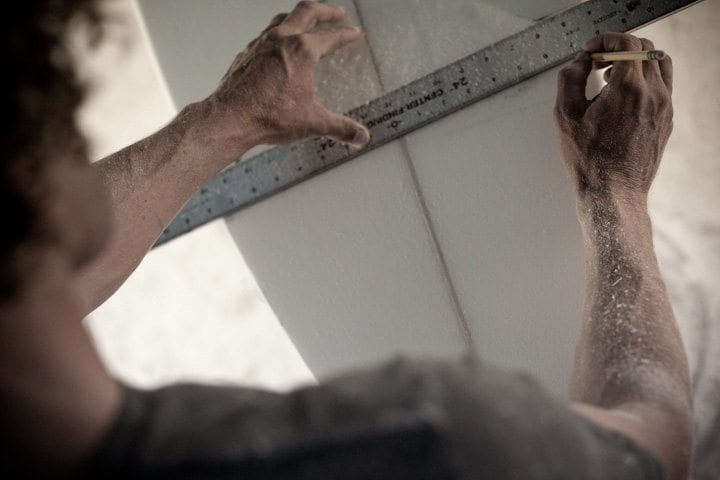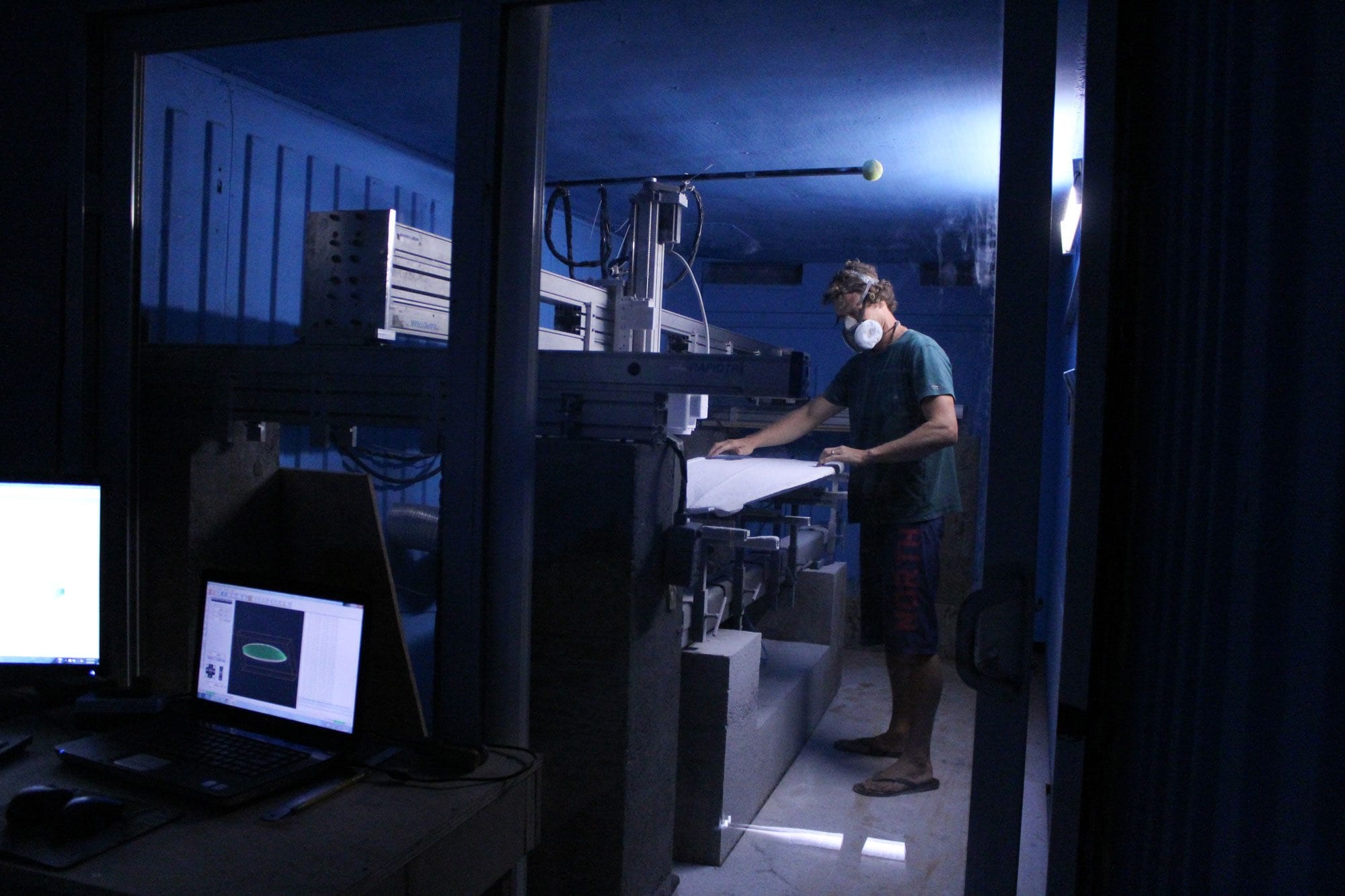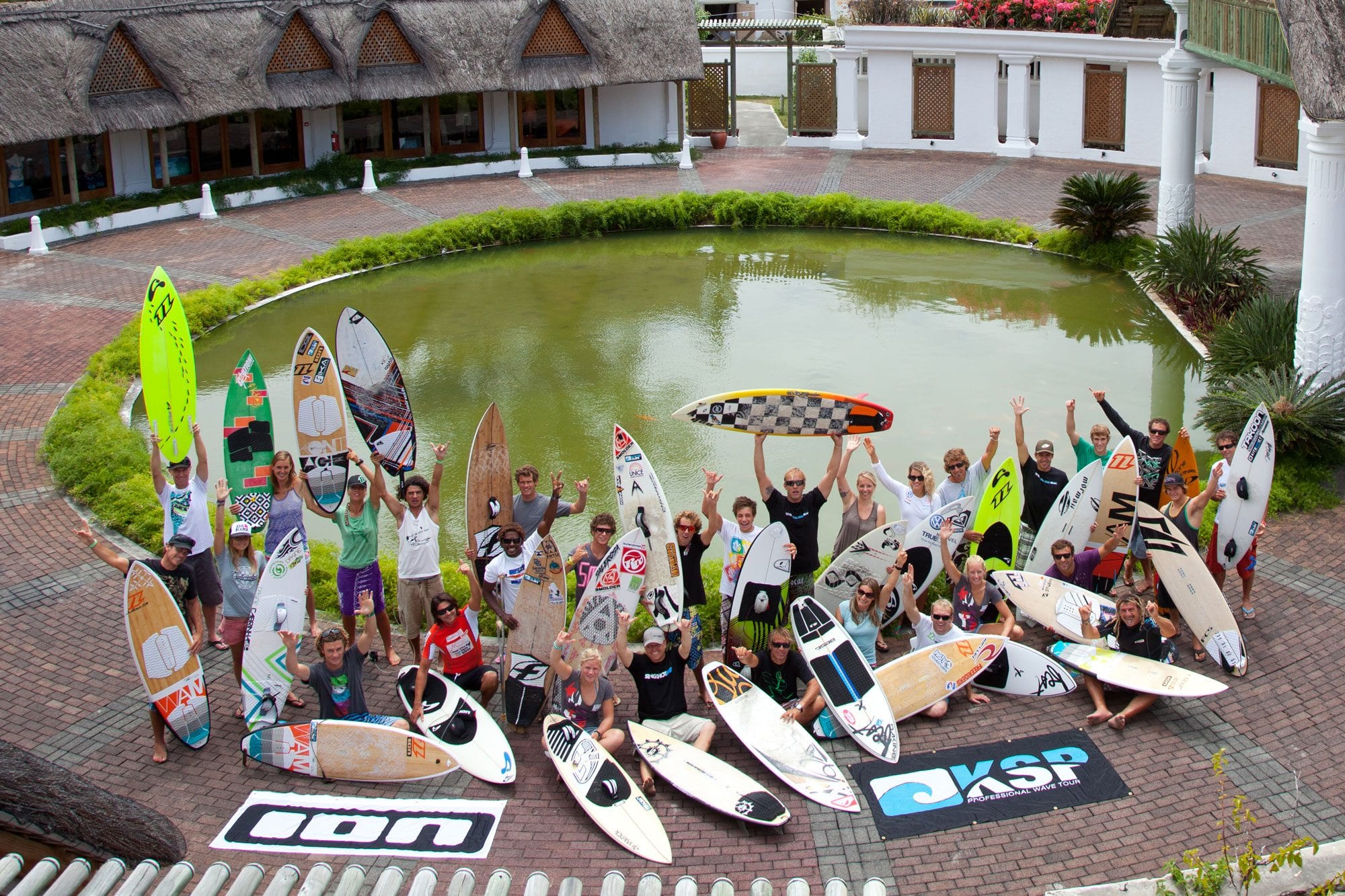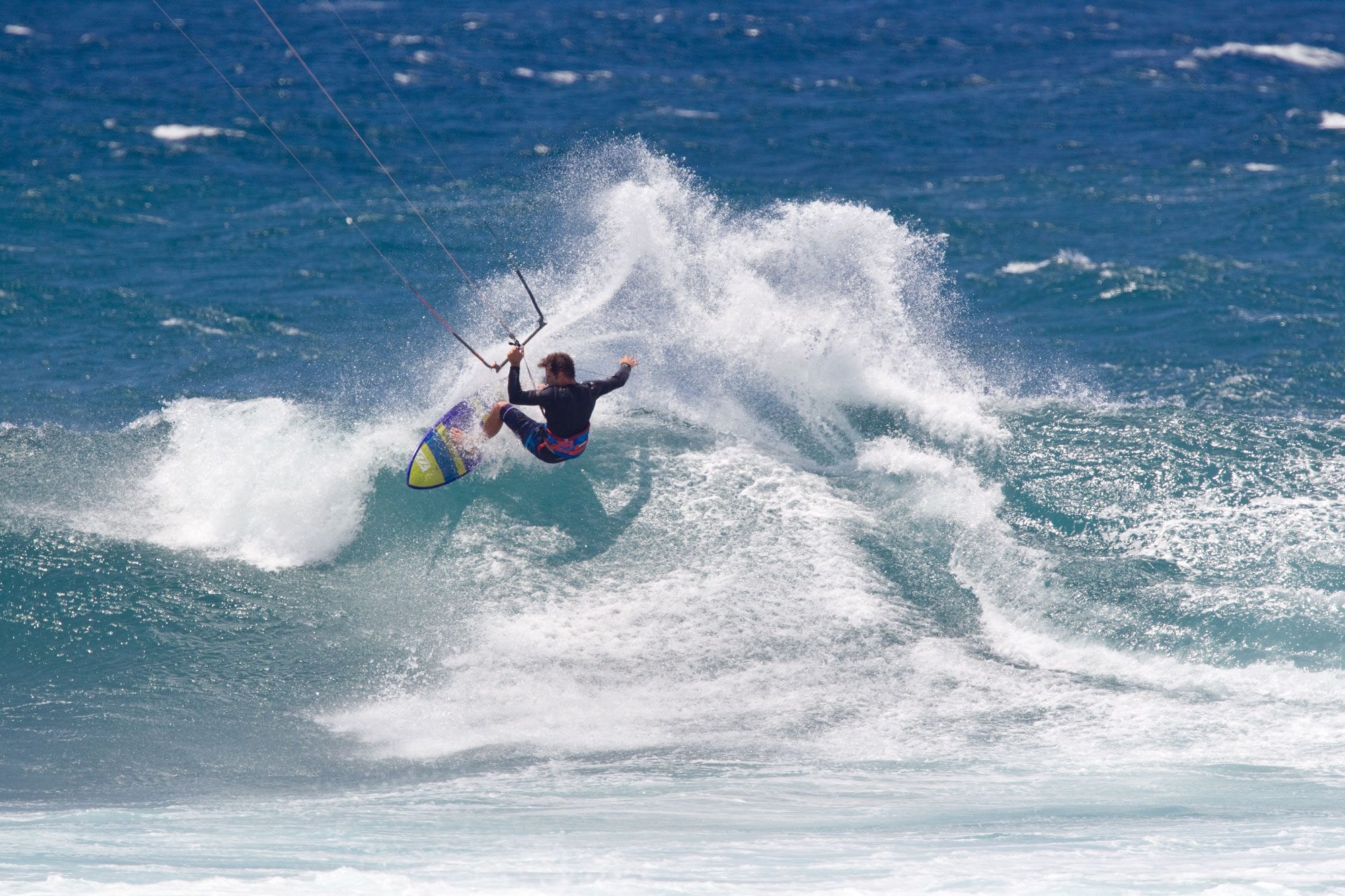The first flush of morning peeks its way through the thick island foliage of Maui’s North Shore as Sky Solbach puts down a steaming cup of coffee, steps off the back porch, checks the creek’s water level and heads over to the goat pen with a bail of alfalfa under one arm. Like most days, Sky has a long list of animals to feed before making his way over to his place of work, a shaping bay on the other side of his property.
The goats are milked and chicken eggs collected when a shrill cacophony erupts from across the yard; two roosters engaged in a death match are trading blood and feathers with no intention of ceasefire. Without deliberation, Sky grabs the aggressor and thanks him for his service before taking a sharpened ax in hand and laying the rooster’s torso across an old Banyan stump. Sky justifies the kill, “If you’re going to eat meat, you ought to know where it comes from and be willing to do the dirty work yourself,” he explains.
Up by the house stands a large shed over the top of a corrugated shipping container. Nestled within the container’s soundproof doors is the workhorse of Sky’s board building enterprise, a CNC machine capable of rough milling a surfboard blank in under 30 minutes. As part of North’s R&D team, one of his primary responsibilities is shaping North’s line of surfboards. Within Sky’s main directive of producing high performance shapes with the lightest tech available, his personal goal is to offset his carbon footprint wherever possible. Everything from the coffee pot to the electric hand planers in his self-built shaping bay are powered by the solar arrays on the roof of his off the grid homestead.

Sky at work balancing the line between performance and art: “in the end the proof is in the riding.” // Photo Adam Koch
Sky Solbach grew up in Auburn, California, a small mountain town just outside of Tahoe. His father, a house builder by trade, escaped Kansas, survived Vietnam and landed on the beaches of San Diego where he met Sky’s mother, a Southern California native. Together, they raised a family of two boys in Northern California’s Sierra Foothills with a life geared towards the active outdoors. Skiing was a family staple, but the Solbach’s quickly adopted windsurfing and began a steady pilgrimage to the calmer waters of nearby Lake Folsom and eventually the legendary Sacramento River Delta.
Growing up, Sky, the youngest of the two Solbach brothers, spent the mid ’80s as a ski rat, however, the waterman seeds were planted at the early age of five when he learned to windsurf in Lake Tahoe’s weekend runoff. Windsurfing quickly became the obsession of the Solbach family ”” so much so that they picked up and moved to Bonaire, a small island in the leeward Antilles of the Caribbean. Enrolled, or more aptly dropped into the island’s small Dutch school, Sky recalls, “I was 8 and my brother was 10. Essentially our parents plopped us down and were like, ”˜here you go, learn Dutch.’” But, the Bonaire transition wasn’t so tough for Sky. School days ended promptly at 12:30pm and the afternoons were filled with windsurfing, handline fishing from the town’s pier and everything else pertaining to the ocean. Sky became fluent in three additional languages: Dutch, Spanish and Papiamentu, a Creole used widely in the Caribbean.
This modern day windsurfing version of the Swiss Family Robinson wasn’t entirely self-supported. In the early years, the absence of proper work permits meant the Solbachs would return stateside during the summers, building houses in Hood River to fund a revolving six month interval of island life.
Ten years later, having completed Dutch high school, Sky was fumbling his way through an uninspired amateur windsurfing career while working for his dad in Hood River. He remembers when the first kites hit the Gorge in the late ’90s on one particular day while windsurfing at the Hatchery. “Lou Wainman and Elliot Leboe came flying by on a downwinder ”” Lou, on this tiny little wakeboard, carved this massive jibe on the inside and that looked insane.” Watching its intensity, Sky wanted to try this new sport but he didn’t have a kite, at least until the following winter in Bonaire when he found himself a Wipika 5.5.
With a solid foundation in windsurfing, Sky learned fairly quick and entered his first competition that winter in St. Martin. That’s when Sky first met Andre Phillip. “We were in the finals together and he beat me. Dre was riding bindings and I had footstraps. I think my best move was a one footer and I tried my first boardoff in the final but didn’t land it.” Sky laughs at the thought of early kiteboarding. “I had only been kiting a couple of months then. I think Dre was doing big spins, jumping high and doing two rotations with a grab; nothing crazy by today’s standards, but for those days he was silky smooth.”
Sky’s progression as a competitor wasn’t overnight, but a series of contests created a long-lined path. In 2002, Sky won a local contest in San Francisco called The King of the Bay, which led Naish, his sponsor at the time, to buy him a plane ticket to the PKRA event in Fuerteventura. While there, he placed second which got him a ticket to Maui’s Red Bull King of the Air where he placed third behind Mark Shinn and Flash Austin. In those days, Sky hadn’t yet landed a pro level paycheck. “I remember mixing concrete with my dad and helping him build houses in between those events.” Sky can’t confirm anything, but the rumor about salaries back then was that the best athletes were pulling in just south of six figures.

Sky undercover at a rarely working, secret outer reef on Maui. According to Sky, “if you’re lucky enough to catch it on the right tide and swell direction it offers some of the best right hand kite barrels I’ve seen.” // Photo Quincy Dein
As Sky entered each additional contest he worked towards better results. “I saw all these guys having fun and traveling all over the place and I just wanted to get on that train.” Eventually, Sky signed a deal with Gaastra. “They made me an offer I couldn’t refuse . . . that was like my first dollar made off of kiteboarding. Essentially, Gaastra was the first paying sponsor of my life.” At this point in his career he had no expectations. “It was like I didn’t know if I’d be doing it for six months or forever. My focus was in the moment; do well at each event to get to the next stop.” In 2003, Sky ended up winning the Germany stop on the World Tour. It was the year Martin Vari and his “space monkeys” crew brought big sent handlepasses to the PKRA. “I was on top of the world, it was like: ”˜yeah I finally made it,’” but that was just about the same time Gaastra’s North American importer imploded and Sky found himself, again, without a paycheck.
Using the connections he had made on tour, Sky found new sponsorship from North Kiteboarding. Fellow tour competitor and longtime friend, Jaime Herraiz, had been an integral part of North Kiteboarding’s R&D alongside legendary kite designer Ken Winner. Sky recalls, “Jaime didn’t tell me at the time, but he lined me up as a team rider with a master plan of transitioning out of R&D and putting me in his spot.” Jaime’s roots were firmly planted in Tarifa, Spain, and at that point the lions-share of North’s testing was split between the Gorge and Oahu.
Jaime started off showing Sky the ropes and his first role was as an assistant to Ken Winner. “We had this house on Oahu that Jaime and Ken rented right on the beach at Gas Chambers between Rocky Point and Pipeline. We’d surf every morning and when it got windy, we’d go to Mokuleia and test kites all day, then we’d go home and surf again.” Sky was still doing some tour stops and remembers competing on North’s classic C-kites: the Rhino and the Vegas. That was when Aaron Hadlow (now a North team rider) first showed up on the tour. Sky remembers the shy, awkward teenager’s first event. “He would kite all day long, first guy out, last guy in. He had kite pants, a seat harness and a handlepass ring,” Sky insists, “that’s definitely on the record. He’ll love that and it’s okay because I think he’s gone on to prove himself legit.”
Eventually, the flukey winters of Oahu were getting in the way of testing and the winter R&D work shifted to Western Australia. In that fortuitous move in 2007, Sky courted Kristin Boese. She was in the country working on her fourth World Championship in a row and Sky was beginning to expand his R&D efforts into surfboard shaping. In haste and typically ill-advised manner, the new couple joined efforts on a piece of property and built a house together in Australia. Call it male optimism, Sky believes there was always some sort of chemistry between the two, but looking back he chuckles, “Yeah it was crazy. We weren’t married or anything, actually I don’t know what we were thinking, we just did it.” Fast forward five years and they are homesteading again, this time on Maui with one little change. Sky, reputedly the non-committal one, proposed when they closed on the new Hawaiian property.

One perk of being a boardshaper and a sponsored rider is the far-flung photo sessions in out-of-this-world locations. // Photo Quincy Dein
If you ask anyone about Sky, they all seem to hone in on one element, his temperament. Ken Winner, the head kite designer at North and the person Sky works most closely with on a daily basis, describes Sky’s defining quality.
“He’s on a very even emotional keel which means that even difficult people, like me, don’t put him off his game, which is to be friendly and helpful to everyone.” — Ken Winner
In an innate sense, Sky exhibits a rare and almost counterintuitive combination of laidback temperament that is coupled with an intense drive for perfection. If you ask Sky whether he’s competitive, he deflects, accusing his brother of being the more competitive of the two; but when it comes to his work, the intensity is present. When confronted, Sky cops to it in an understated way, “I want to have the best boards in the market, and the same with the kites too. I guess we’re really competitive in that way ”” Ken and I ”” we don’t want to be average.”

An undercover operation: Sky Solbach, cloistered in a soundproof shipping container, rough-cutting surfboard blanks with his CNC machine. // Photo Kristin Boese
Design and development in Sky’s shaping bay is a process of constant evolution. Sky isn’t afraid of failure. “It’s important to make mistakes and make bad boards so you learn what makes a good board.” He operates in a flexible medium of design principles, “You develop your own theories over time, which sometimes you prove wrong and you realize there’s a better way to do it.” And from Ken Winner, he’s learned that the best way to push development forward is through relentless testing. “You have to get it in the water and ride it. You have to know what you want and keep trying until you get the feeling you’re searching for. You can have all the greatest theories and science behind surfboards but the proof is on the water.” When it comes to Sky’s unique design talents, Ken finds Sky to be, “extremely sensitive to what is happening with a prototype kite or a prototype board, and as a result, he provides the best possible kite and board design feedback.“ This kind of precision sense is a learned trait, a sensitivity honed through hours of mastering the intricate interchange of technique and equipment, something you get on the freestyle tour.
Surfing has always been a part of Sky’s repertoire, but in the early days, the connection between kiting and surf was tenuous. It was the years he spent in Australia that changed his focus from freestyle to kiting in the waves. Sky remembers kiting with Jaime and discovering the potential of strapless riding. That was the year of the Rebel. “All of a sudden, we had the ability to depower our kites. Before that, the forefront of kitesurfing was riding unhooked with no depower and footstraps, which was cool, but it was really limiting. Once we had depower and started riding hooked-in, we got rid of our footstraps and that was a game changer.”
The progression in surf was fast changing, but by 2011, the professional kiteboarding tour hadn’t evolved in step. The surf events were piggybacked on freestyle tour stops and rarely held in solid surf conditions. The few events that happened to have great waves, like the PKRA event in Chile, suffered from judges geared towards freestyle. As the surf athletes in the industry, like Sky, were becoming hyperfocused on the progression of kitesurfing in the strapless direction, the PKRA events just seemed like a joke.
In 2011, Sky and his then girlfriend, Kristin Boese, organized a meeting with top strapless riders, Mitu Monteiro and Guilly Brandão, to talk about the creation of a new surf tour. They filed all the paperwork for sanctioning by IKA and collaborated with the best surfers to develop new judging criteria. The tour was called the Kite Surf Pro Tour (KSP), and the format was based on what you’d see in mainstream surfing’s ASP tour. “We maintained two-week waiting periods to ensure the best surf and we’d only hold it in the best locations in the prime period for waves and wind.” Solbach was sure that live video streaming was going to be the key to cracking the marketing/sponsorship nut, “If you have to read a press release or watch a wrap-up video about an event, its old news. If you want to have an impact and dedicated fans, you have to have live stream; they have to be living in the moment with you as the event’s happening.”
The KSP’s inaugural event fired straight out of the pipe, with Mauritius banging on all six cylinders. Sky recalls One Eye pumping the whole time. “The wave quality was insane and everyone rode strapless as the judging guidelines were all about commitment. Mauritius was the game changing event that silenced all the critics about strapless riding.”
On the surface, the KSP was the most progressive thing to happen to the world of kitesurfing, but the backend was bedlam.
The stress behind the KSP years is still palpable in Sky’s voice. “The tour was the beginning of three years of hell, with some really nice highlights in between, but for the most part it, it was a really tough stretch.” Kristin was the tour manager and although Sky never had an official title, he was involved in every last detail. Although Mauritius was a giant success, the following events didn’t get any easier. Airline sponsors pulled out last minute and shady on-site event promoters [names redacted to protect the guilty] burned the KSP non-profit by walking away with tourism money, leaving Sky and Kristin digging deep into their own pockets to bridge the gaps.
People around the world were watching kiting’s first legitimate surf contest in real time. Sky explains, “Our starting point for an event was about choosing the perfect location for the quality of its wave and then trying to figure out how we could make it happen in that spot.” Newly established venues offered consistent A-frame waves and a roster of world-class competitors going for broke, yet behind the scenes, it was occurring at great personal cost. It seems like an insulting proposition: deliver the contest formula that riders want, the exposure that equipment and sponsors desire, but somehow, at the end of the day, you’re throwing in your own money to prop it up with the vague hope that the tour will pay you back one day.
Aside from the great personal investment of time and energy, for Sky, the KSP has personal significance beyond ownership. He points to a rider like Airton Cozzolino. “Before the KSP there was no real world tour where a rider like him could really showcase his talents on a worldwide platform.” The KSP kick-started Airton’s career and now sponsors like Red Bull and North Kites are flying him all over the world. Competition is the platform Sky used to get his first sponsor and it led to the privilege of making a living in the kite industry. This significance is not lost on Sky, and perhaps that’s why he feels for those professional kitesurfers that have nowhere to go.
Sky would love to see a tour again, the format and infrastructure on judging guidelines is all there, but for the time being, Sky and Kristin have invested their energy into building a sustainable life on their new property on Maui’s North Shore. With Sky’s building background, they’ve created a rich but simple off-the-grid existence. Everything from the dishwasher to the power tools in Sky’s shaping bay is fed by the solar panels mounted to their roof. “You can’t just turn on the clothes dryer whenever you want, you might have to wait until it’s sunny or you have to think about the charge in your batteries, but it’s just another step closer to living in harmony with nature.” Thinking twice before you flip on a light switch isn’t for everyone, but neither is taking on small-scale farming. Kristin and Sky have 35 chickens, seven turkeys, five goats, honey producing beehives and an aquaponic system for growing fish. The Tilapia fingerlings swimming in Sky’s tanks are still growing but in a few months the Solbachs will have their own sustainable source for fish as well as fertilizer for their plants. The goats get milked, the chickens eaten and when the surf is good, Sky heads to the reefs just down the road. Sky’s surf spots aren’t well known, but he insists there are some really good waves, local style.
There are a lot of well-renound athletes from Sky’s PKRA days that have completely cashed out of kiteboarding. When the question of longevity is posed, Sky ponders, “I think if I wasn’t having fun I’d definitely move onto something else, but I’ve been lucky enough to find new aspects to kiting that have kept my interest.” Sky’s first attraction to kiting was competition and that lead to developing kites and eventually to full immersion in the art of shaping surfboards. The fortuitous is not lost on Sky. “Other people probably have the same interests, but they don’t have the opportunity to do what I do because I’ve been really lucky, both to be a part of North and at the same time, that North has grown into what it is today.” While Sky attributes his success to luck, the sum total of Sky’s endeavors suggest a more likely cause: the intersection of hard work and opportunity.
This article was first featured in the spring 2016 issue of The Kiteboarder Magazine. Want more like this? Subscribe here: https://www.thekiteboarder.com/product/magazine-subscription/


